
PiHKAL: A Chemical Love Story is a book by Dr. Alexander Shulgin and Ann Shulgin, published in 1991. The subject of the work is psychoactive phenethylamine chemical derivatives, notably those that act as psychedelics and/or empathogen-entactogens. The main title, PiHKAL, is an acronym that stands for "Phenethylamines I Have Known and Loved".
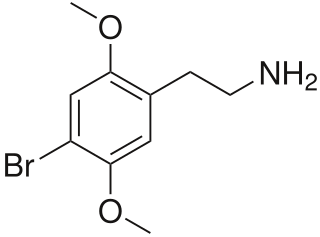
2C-B (4-Bromo-2,5-dimethoxyphenethylamine) is a psychedelic drug of the 2C family. It was first synthesized by Alexander Shulgin in 1974. In Shulgin's book PiHKAL, the dosage range is listed as 12–24 mg. As a recreational drug, 2C-B is sold as a white powder sometimes pressed in tablets or gel caps. It is also referred to by a number of street names. The drug is usually taken orally, but can also be insufflated or vaporized. While being primarily a psychedelic it is also a mild entactogen.

2C-P is a relatively potent and long acting psychedelic phenethylamine of the 2C family.
The Shulgin Rating Scale is a simple scale for reporting the subjective effect of psychoactive substances at a given dosage, and at a given time. The system was developed for research purposes by the American biochemist Alexander Shulgin, and published with co-authors Ann Shulgin and Peyton Jacob, III, in a 1986 issue of the journal Methods and Findings in Experimental and Clinical Pharmacology. It was later described in the Shulgins' popular 1991 book PIHKAL: A Chemical Love Story.
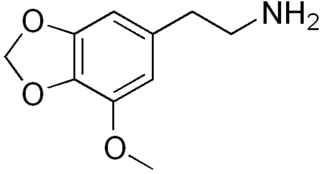
Lophophine is a putative psychedelic and entactogen drug of the methylenedioxyphenethylamine class. It is the α-demethylated homologue of MMDA, and is also closely related to mescaline.

3,4-Methylenedioxy-N-hydroxyamphetamine is an entactogen, psychedelic, and stimulant of the phenethylamine and amphetamine chemical classes. It is the N-hydroxy homologue of MDA, and the N-desmethyl homologue of MDHMA. MDOH was first synthesized and assayed by Alexander Shulgin. In his book PiHKAL, Shulgin listed the dosage range as 100–160 mg, and the duration as approximately 3–6 hours. He describes MDOH as being very psychedelic and producing increased pleasure in beauty and nature. He also mentioned several negative side effects also seen with MDMA ("Ecstasy") such as difficulty urinating and internal dryness.

3,4-Methylenedioxyphentermine (MDPH) is a lesser-known psychedelic drug. MDPH was first synthesized by Alexander Shulgin. In his book PiHKAL , the dosage range is listed as 160–240 mg, and the duration as 3–5 hours. MDPH's effects are very similar to those of MDA: they both are smooth and "stoning," and do not cause any visuals. They also alter dreams and dream patterns. Shulgin describes MDPH as a promoter; it promotes the effects of other drugs, similarly to 2C-D. Very little data exists about the pharmacological properties, metabolism, and toxicity of MDPH.

Isomescaline (2,3,4-trimethoxyphenethylamine) is a lesser-known compound based on a well-known psychedelic drug. It is an isomer of mescaline, as well as an analog of TIM-2, TIM-3, and TIM-4. Isomescaline was first synthesized by Alexander Shulgin. In his book PIHKAL, it is suggested that any potentially active dose would be "greater than 400 mg". Despite its structural similarity to mescaline, isomescaline has produced no effects in humans. Very little data exists about the pharmacological properties, metabolism, and toxicity of isomescaline.
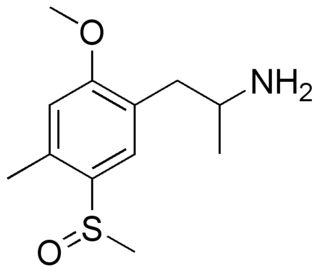
TOMSO (2-methoxy]]-4-methyl-5-methylsulfinylamphetamine) is a lesser-known psychedelic drug and a substituted amphetamine. TOMSO was first synthesized by Alexander Shulgin. In his book PiHKAL, the dosage range is listed as 100–150 mg, and the duration listed as 10–16 hours. TOMSO is inactive on its own; it is activated with the consumption of alcohol. It produces intense time distortion and a threshold. Very little data exists about the pharmacological properties, metabolism, and toxicity of TOMSO.

Ariadne is a lesser-known psychedelic drug. It is a homologue of 2C-D and DOM. Ariadne was first synthesized by Alexander Shulgin. In his book PiHKAL, Shulgin reported testing Ariadne up to a dose of 32 mg, and reported that it produces psychedelia at a bare threshold. Very little data exists about the pharmacological properties, metabolism, and toxicity of Ariadne in humans apart from Shulgin's limited testing.

BOH, also known as 3,4-methylenedioxy-β-methoxyphenethylamine, is a drug of the phenethylamine class. It is the β-methoxy analog of methylenedioxyphenethylamine (MDPEA) and is also more distantly related to methylone. On account of its similarity to norepinephrine, the effects of BOH may be of a purely adrenergic nature.

2,5-Dimethoxy-3,4-methylenedioxyamphetamine (DMMDA) is a psychedelic drug of the phenethylamine and amphetamine chemical classes. It was first synthesized by Alexander Shulgin and was described in his book PiHKAL. Shulgin listed the dosage as 30–75 mg and the duration as 6–8 hours. He reported DMMDA as producing LSD-like images, mydriasis, ataxia, and time dilation.

2,5-Dimethoxy-4-ethoxyamphetamine (MEM) is a psychedelic drug of the phenethylamine and amphetamine chemical classes. It was first synthesized by Alexander Shulgin. In his book PiHKAL, he lists the active dose range as 20–50 mg, and the duration as 10–14 hours. According to Shulgin, MEM produces color enhancement, visual phenomena, and pattern movement, among other effects.
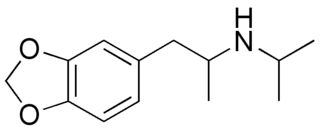
3,4-Methylenedioxy-N-isopropylamphetamine is a psychoactive drug of the phenethylamine and amphetamine chemical classes which acts as an entactogen, psychedelic, and stimulant. It is the N-isopropyl analogue of 3,4-methylenedioxyamphetamine (MDA). MDIP was first synthesized by Alexander Shulgin. In his book PiHKAL, the minimum dosage is listed as 250 mg. MDIP produces a mild threshold. Very little is known about the pharmacology, pharmacokinetics, effects, and toxicity of MDIP.
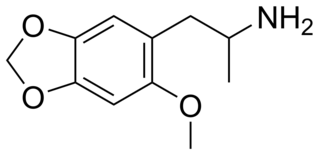
MMDA-2 (2-methoxy-4,5-methylenedioxyamphetamine) is a psychedelic drug of the amphetamine class. It is closely related to MMDA and MDA.
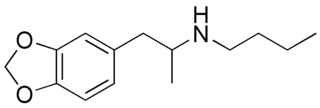
Methylenedioxybutylamphetamine is a lesser-known psychedelic drug. It is also the N-butyl derivative of 3,4-methylenedioxyamphetamine (MDA). MDBU was first synthesized by Alexander Shulgin. In his book PiHKAL, the minimum dosage is listed as 40 mg, and the duration unknown. MDBU produces few to no effects. Very little data exists about the pharmacological properties, metabolism, and toxicity of MDBU.

Methylenedioxybenzylamphetamine, abbreviated MDBZ, and systematically named 3,4-methylenedioxy-N-benzylamphetamine, is a psychedelic drug. It is the N-benzyl derivative of 3,4-methylenedioxyamphetamine (MDA). MDBZ was first synthesized by Alexander Shulgin. In his book PiHKAL , the minimum dosage is listed as 150 mg, and the duration unknown. MDBZ produces few to no effects. Very few data exist about the pharmacological properties, metabolism, and toxicity of MDBZ.

5-Methyl-3,4-methylenedioxyamphetamine (5-Methyl-MDA) is an entactogen and psychedelic designer drug of the amphetamine class. It is a ring-methylated homologue of MDA and a structural isomer of MDMA.

3-Methoxy-4-methylamphetamine (MMA) is an entactogen and psychedelic drug of the phenethylamine and amphetamine classes. It was first synthesized in 1970 and was encountered as a street drug in Italy in the same decade. MMA was largely forgotten until being reassayed by David E. Nichols as a non-neurotoxic MDMA analogue in 1991, and has subsequently been sold as a designer drug on the internet since the late 2000s (decade).

βk-2C-B is a novel psychedelic substance. It is the beta (β) ketone structural analogue of 2C-B, a psychedelic drug of the 2C family. It is used as a recreational drug, usually taken orally. βk-2C-B is a controlled substance in Canada, Germany, Switzerland, and the United Kingdom.



















